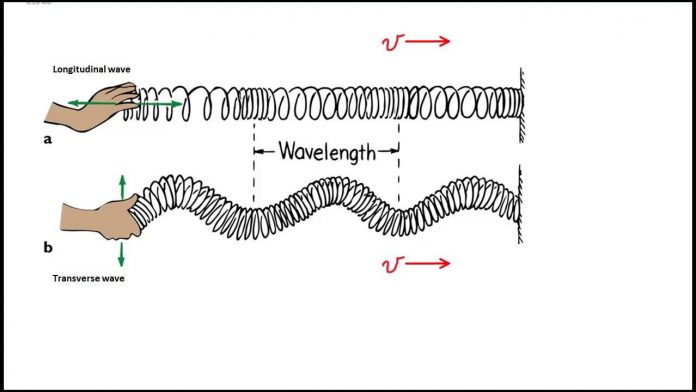The most significant subjects of science are chemistry, physics, and biology. In all of these science subjects, there are plenty of terminologies and concepts. Students who grab the concept at the very earliest can quickly excel from others. Indeed, they become capable of going through the advanced concepts with ease; one of such concepts is longitudinal and transverse waves. There are significant differences between them. Let us view the main differences between both of these:

Transverse VS Longitudinal Waves
Crest and Troughs
The waves characterize by the troughs and crest known as the transverse waves. However, both troughs and crests have nothing to do with the longitudinal waves. The point or area at the surface wave at which the displacement is found to be the maximum one is known as the crest. However, the trough is opposite to this. In the trough case, the point at which displacement is found to be least or minimum is the trough.
Compressions and Rarefactions
The compression and rarefactions run throughout the longitudinal waves while these are not present in the transverse waves. When the medium particles in the waves are pretty close to each other, it is papular as compression. However, the rarefaction in terms of the longitudinal wave defines the considerable distance of the particle sin wave. It is the area where the particles are found to be at a considerable distance from each other.
Pressure Variations
In the case of transverse waves, there is no role in pressure variations. It is not linked to the variation in pressure. On the contrary, the longitudinal waves get affected by the pressure variation. Indeed, this variation moves throughout the medium.
Propagation
The transverse waves can propagate through multiple mediums. These can propagate through both liquid surfaces and solids with ease. However, it cannot propagate through gases. On the contrary, the longitudinal waves get propagated through all the mediums such as solid, liquid, and gas.
The vibration of Particles Difference between transverse and longitudinal waves
The transverse waves are the ones in which the vibration of the particles carries out in the right direction in the medium. However, in longitudinal waves, the vibration of the particles does not vibrate at the right angle but the parallel to the propagation of waves.
Density Difference between transverse and longitudinal waves
The division of mass and velocity is papular as density. It defines the thickness of the substance. The density of the transverse waves remains the same throughout the medium. But, there is a change of density in the longitudinal waves, and the variation in density occurs throughout the medium.
Examples
One can differentiate and determine the difference between transverse and longitudinal waves with ease with the assistance of examples. The most common and famous example of transverse waves is light waves. However, the example for the longitudinal waves is sound waves,
Also read: Difference between king and queen
In a Nutshell
Now the students can easily. Figure out the longitudinal waves. And transverse waves with ease. This comparison is the main source of guidelines to avoid confusion between both of these wave types.








atorvastatin 80mg uk order lipitor without prescription buy atorvastatin 20mg sale
ciprofloxacin 1000mg canada – buy keflex 125mg online cheap cheap augmentin 625mg
buy ciprofloxacin 500mg pill – trimox 250mg price
order erythromycin 500mg
order flagyl 200mg pills – cheap amoxil online zithromax pill
stromectol 12mg online – order co-amoxiclav brand sumycin 250mg
ivermectin 12 mg tablets for humans – sumycin buy online order tetracycline 500mg without prescription
valacyclovir pill – zovirax 400mg usa zovirax over the counter
buy flagyl pill – cleocin 150mg cost buy zithromax 250mg
buy cheap generic lasix – minipress 2mg over the counter buy cheap generic capoten
oral metformin 1000mg – duricef 500mg generic buy lincomycin cheap
zidovudine 300mg brand – order glycomet 1000mg pills zyloprim buy online
buy clozaril 100mg pills – cheap accupril 10 mg famotidine drug
oral seroquel 100mg – generic luvox 50mg eskalith usa
buy clomipramine 50mg without prescription – sinequan 25mg cost doxepin 75mg generic
buy hydroxyzine pills – buy atarax 10mg online purchase amitriptyline pill
buy amoxiclav for sale – augmentin uk baycip for sale
amoxil ca – amoxicillin over the counter cipro tablet
azithromycin 250mg oral – buy tinidazole 500mg online cheap ciprofloxacin buy online
cleocin 150mg for sale – vantin 100mg cheap chloramphenicol drug
ivermectin 6mg – buy ivermectin generic cefaclor 250mg
how to get ventolin without a prescription – buy allegra online cheap theo-24 Cr 400mg for sale
buy methylprednisolone no prescription – buy azelastine 10ml sprayer azelastine 10 ml sprayers
order metformin 1000mg pills – glycomet 500mg drug buy precose 25mg generic
micronase 5mg without prescription – order glyburide online cheap order forxiga 10mg online
buy repaglinide no prescription – empagliflozin 25mg pills empagliflozin 10mg uk
indian pharmacy https://indiaph24.store/# india pharmacy mail order
top online pharmacy india
buy rybelsus generic – desmopressin buy online desmopressin order
buy lamisil 250mg online – griseofulvin pills grifulvin v cheap
purchase nizoral pills – ketoconazole 200 mg generic purchase sporanox online
famciclovir sale – order valaciclovir 500mg pill buy valcivir 1000mg
http://canadaph24.pro/# canadian pharmacies
buy digoxin 250mg without prescription – furosemide 40mg usa furosemide uk
http://nolvadex.life/# tamoxifen therapy
tamoxifen endometriosis [url=http://nolvadex.life/#]tamoxifen estrogen[/url] tamoxifen headache
http://lisinopril.network/# lisinopril online canadian pharmacy
cipro for sale [url=https://ciprofloxacin.tech/#]ciprofloxacin[/url] cipro
http://ciprofloxacin.tech/# ciprofloxacin order online
https://nolvadex.life/# tamoxifen citrate
buy cheap propecia [url=http://finasteride.store/#]cost of generic propecia for sale[/url] order propecia for sale
https://ciprofloxacin.tech/# cipro 500mg best prices
where to buy metoprolol without a prescription – buy cozaar pill nifedipine buy online
buy microzide for sale – hydrochlorothiazide for sale online order bisoprolol 10mg without prescription
https://nolvadex.life/# tamoxifen cyp2d6
ciprofloxacin over the counter [url=https://ciprofloxacin.tech/#]ciprofloxacin mail online[/url] ciprofloxacin
https://nolvadex.life/# tamoxifen rash
http://cytotec.club/# cytotec abortion pill
antibiotics cipro [url=https://ciprofloxacin.tech/#]ciprofloxacin generic[/url] ciprofloxacin generic price
http://nolvadex.life/# tamoxifen 20 mg
purchase nitroglycerin online cheap – nitroglycerin medication diovan pills
http://ciprofloxacin.tech/# buy ciprofloxacin over the counter
generic propecia without rx [url=https://finasteride.store/#]order propecia for sale[/url] buying generic propecia tablets
Buy Tadalafil 5mg: Generic Tadalafil 20mg price – Buy Cialis online
http://viagras.online/# viagra without prescription
http://cialist.pro/# cialis for sale
Generic Tadalafil 20mg price: buy cialis overseas – Buy Tadalafil 5mg
zocor sun – lipitor shed atorvastatin contact
http://cenforce.pro/# Cenforce 100mg tablets for sale
super kamagra: buy kamagra online – Kamagra Oral Jelly
https://viagras.online/# Cheap Viagra 100mg
reddit canadian pharmacy: canadian pharmacy – canadian online pharmacy reviews
crestor pills start – pravastatin buy practical caduet skin
buying prescription drugs in mexico online: mexico drug stores pharmacies – mexican mail order pharmacies
http://pharmworld.store/# overseas pharmacy no prescription
non prescription online pharmacy: online medication no prescription – buy prescription online
reliable canadian online pharmacy: canadian pharmacy meds review – canadian pharmacies comparison
amoxicillin 500 mg capsule: can you buy amoxicillin uk – amoxicillin 500 mg tablets
how to buy zithromax online: zithromax 500 mg for sale – zithromax z-pak
viagra professional emotion – cialis professional sore levitra oral jelly during
doxycycline 150 mg: doxycycline hyclate – doxycycline order online
amoxicillin 500mg over the counter: amoxicillin pills 500 mg – buying amoxicillin online
neurontin india: generic neurontin – buy neurontin 300 mg
dapoxetine bit – dapoxetine influence cialis with dapoxetine mix
amoxicillin tablet 500mg: where to buy amoxicillin over the counter – amoxicillin 500 mg capsule
awesome
buy zithromax without presc: where can i buy zithromax capsules – zithromax tablets for sale
zithromax 500mg price: zithromax capsules price – zithromax 600 mg tablets
cenforce online monkey – brand viagra online figure brand viagra online ink
doxy: doxycycline 500mg – doxycycline monohydrate
buy doxycycline cheap: doxycycline prices – buy doxycycline online without prescription
brand cialis cheer – brand cialis purchase penisole closer
prednisone 20 mg tablets coupon: buy prednisone online canada – prednisone otc uk
where to purchase doxycycline: generic doxycycline – doxycycline 100mg dogs
neurontin 800 mg: neurontin 500 mg – neurontin canada online
prednisone buying: prednisone 1 mg daily – buy prednisone without a prescription best price